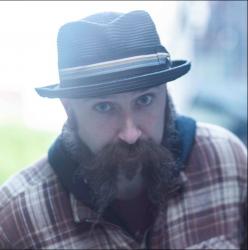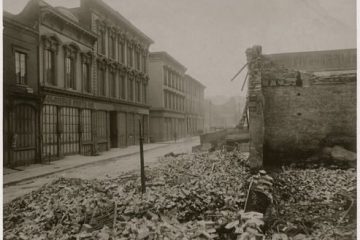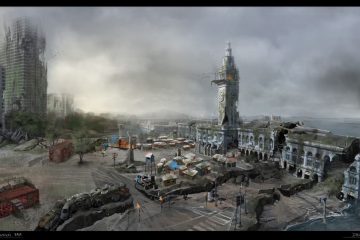Did San Francisco’s Oldest Bar, The Saloon, Actually Burn Down in 1906?
The Saloon, in North Beach, is regularly touted as San Francisco’s oldest bar, dating back to 1861. While other bars were started sooner, their original buildings were destroyed during the 1906 earthquake and fire. The Saloon miraculously survived thanks to the firefighters and sailors that stretched a hose from the Bay in order to rescue the prostitutes that lived above the watering hole.
At least that’s the story that’s told, and, as Mark Twain supposedly said, “Never let the truth get in the way of a good story.” Unfortunately, much like his pervasive quip concerning cold San Franciscan summers, there’s not much evidence that he said either of those. A local historian has also gathered some information that might make you reconsider the Saloon’s miraculous survival.

The Saloon, present-day. North Beach, San Francisco.
On January 8, 2019, Angus Macfarlane made a presentation to the San Francisco Historical Society, titled “Julia Herzog and the Myth of the Saloon.” I caught up with him later to get the details over a few adult beverages.
“Well, I always thought there was something strange about the story of this wooden building in a neighborhood of wooden buildings surviving the conflagration of the 1906 fire,” said Macfarlane. “The first thing I thought was, ‘I can just debunk that thing about the hose. It’s preposterous.’ Well, it turns out, not only was that hose story not preposterous, there were five hoses according to reports form the firefighting companies.”
While that might seem to reinforce the Saloon’s survival tale, Macfarlane interprets the records differently. The five hoses were stretched from the Bay to subterranean cisterns that were used to defend the entire area, not just one building. He notes that San Francisco’s notorious and powerful political boss, Abe Ruef, lost property near Montgomery and Columbus, and if they couldn’t save his property…
Ok, sure, but what about the working girls that lived above the Saloon? Wasn’t that the special reason the place was saved?
Well, according to the 1900 Census, the were no prostitutes living above the Saloon at the time. Besides the saloon keeper, “Silverio Fiorio,” and his family, the residents listed at 1232 Dupont street include a musician, a bartender, a cook, a “hod carrier” (bricklayer), a saddler, and an artist.
“Nothing hinky going on there,” said Macfarlane.
A lot can change in six years, and it’s certainly possible that the best durned scarlet damsels moved in before the firestorm. And there was one person listed as having “no occupation,” so that could have been the most popular girl in town. But besides that, there is evidence of where the sex workers did live.

Another slide from Macfarlane’s presentation, a 1905 City map, showing where the Female Buildings were.
“This is a little closer,” said Macfarlane, pointing to a map of the area. “This shows where the whorehouses where. They’re even marked ‘Fem B-D-G.’ It’s a ‘Female Building.’ So they’re in the area but the Saloon is a family and renters.”
The timeline of the fire also doesn’t support the supposed rush to save the women above the barroom.
“The fire didn’t get to North Beach until the third day,” said Macfarlane. “So these ladies were not hanging out the windows for three days saying, ‘Help me, help me.’ If they were there – and they weren’t, they were across the street and around the corner and down the alley and on the other side of the block – they had lots of time to pack up and move on.”
“Here’s a picture of people watching the fire from Russian Hill approaching North Beach,” he said. “So it’s not like, ‘The tornado’s going to hit in twenty minutes, get out.’”
In addition to presenting evidence contrary to the Saloon’s survival, Macfarlane points out that there is a lack of evidence supporting the story. Where is the picture of the Saloon standing alone amongst the rumble? Other buildings that made it through the tragedy, like Hotaling’s Whiskey, were featured in newspaper stories. Pictures exist of remaining stone edifices like the Saint Francis Hotel on Union Square and the Palace on Market Street. Not so for the Saloon.

A plaque on the side of the Hotaling Building, courtesy of the ancient and honorable Order of E Clampus Vitus, who are dedicated to the preservation of the heritage of the American West.
“In a Sherlock Holmes story, there was a dog that didn’t bark in the middle of the night,” said McFarlane. “Why didn’t the dog bark? Well, the reason was that its owner was the bad guy. So, this lack of a picture of an incredible survivor is like the dog that didn’t bark. ”
One of the least barking-est dogs, if you will, is a picture of the Saint Francis Church. Because of it, we know that there was a photographer directly in front of where the Saloon would have been in the days after the destruction. Why wouldn’t the photographer turn around and capture the one remaining wooden structure in a sea of brick and rumble?
“What I really went overboard on, in my presentation,” said Macfarlane. “Was bringing in a lot, a lot, a lot of circumstantial evidence about how the Saloon surviving was a myth. Then I showed the picture and said, ‘This is the block that it’s on and it’s not there.’
It’s a little contentious, hard to see clearly, but it seems that every wooden building in the area was laid to waste.

Another image from Macfarlane’s presentation, showing the distance between the church, the Saloon, and the jail. “The pink, those are brick structures,” he said. “The yellow, those are wood structures.”
“It’s just devastation,” said Macfarlane. “The county jail was on Broadway, and it was like the Bastille of San Francisco. You’re not going to break into it, you’re not going to break out of it. It was quarried stone.”
As mentioned, Macfarlane became interested in the Saloon’s story while researching a female entrepreneur and her impressive group of bars. The question of which bar was the oldest stuck with him
“She was born in Ireland, we know that,” said Macfarlane. “When she came to the United States, we don’t know. When she was married exactly, we don’t know. Her husband was named Anton Herzog, her first name was Julia – don’t know her maiden name. These records are lost in the earthquake and fire.”
“What remains of her legacy and its amazing story that I’ve pieced together, is where we’re sitting right now, the Little Shamrock on Lincoln Way, which is the oldest continuously operating bar in San Francisco. It’s been in continuous operation since 1893 without an asterisk or any question.”
Regardless of whether the Saloon burned down or not, the North Beach staple remains as much a part of San Francisco history as any cable car or pint of Anchor Steam. If you’ve never shuffled to the blues there, you’re just missing out. To enter is truly to step back in time. Furthermore, it absolutely has been a boozehall since 1861.
“There are records going back to 1861,” admits McFarlane. “They were established in 1861, no question about that.”
Those interested in SF History can catch presentations similar to Macfarlane’s on the second Tuesday of each month. The next, June 11, will explain some of the odd origins of items found in SF public parks. Have you heard the history of the Spanish monastery, purchased by William Randolph Hearst, and eventually abandoned in Golden Gate Park? For more info, go to: SFHistory.org.





























